
Art | Resources
The Short List of Rules for Choosing Products

I can’t tell you who wrote this because the person who sent it to me didn’t know, but I felt it was worth passing along.
Inspired by Michael Pollan’s Food Rules, here is a short list of guidelines for choosing products—any product.
I couldn’t have said it better myself.
ELEVEN RULES FOR CHOOSING PRODUCTS
- If it is cheap, it probably has hidden costs.
- If it starts as a toxic input (like ethylene glycol in the manufacture of polyester), you probably don’t want it in your house or office.
- Use materials made from substances you can imagine in their raw or natural state.
- Use carbohydrate-based materials (i.e., natural fibers) when you can.
- Just because almost anything can kill you doesn’t mean fabrics should.
- Pay more, use less.
- Consult your nose – if it stinks, don’t use it.
- If they can’t tell you what’s in it, you probably don’t want to live with it. (Note: this is not just the fibers used to weave the fabric – did the processing use specific chemicals, like heavy metals in the dyestuff, or are there any finishes on the fabric?)
- Avoid materials that are pretending to be something they are not (like polyester mimicking linen).
- Question materials that make health claims.
- Regard space-age materials with skepticism.
The Clean Bedroom
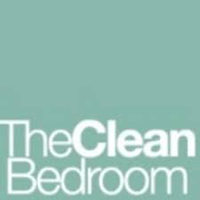 Everything you need to create a toxic-free bedroom all in one place. Organic mattresses and bedding, organic crib mattresses and nursery bedding, and bedroom furniture–nontoxic, chemical-free and hypoallergenic. They provide personalized service to fit the health and comfort needs of each customer. Articles and blog posts provide helpful information for allergy sufferers and patients with multiple chemical sensitivities, and product comparisons assist customers in making the right purchase decisions.
Everything you need to create a toxic-free bedroom all in one place. Organic mattresses and bedding, organic crib mattresses and nursery bedding, and bedroom furniture–nontoxic, chemical-free and hypoallergenic. They provide personalized service to fit the health and comfort needs of each customer. Articles and blog posts provide helpful information for allergy sufferers and patients with multiple chemical sensitivities, and product comparisons assist customers in making the right purchase decisions.
Marketplace: Handwork of India
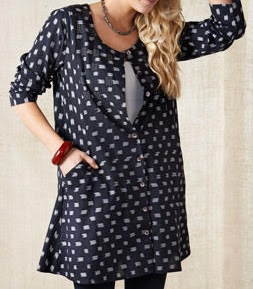 Really beautiful, colorful clothing made of cotton and other natural fibers in India. All women’s sizes, including plus sizes. “MarketPlace: Handwork of India is a pioneering nonprofit that empowers women in India to break the cycle of poverty, as they become leaders in their work, their homes, and their neighborhoods, and effect lasting change in their communities. In MarketPlace’s comprehensive and creative organization, economic development is only the first step for these brave and resourceful women. We work with over 400 artisans who are organized into 11 independent co-operatives that produce high-quality women’s apparel and home decor. They learn skills such as sewing and embroidery, and participate in all aspects of running the cooperatives. In addition, programs offer educational and enrichment opportunities designed to help the artisans overcome personal, cultural and financial obstacles. ”
Really beautiful, colorful clothing made of cotton and other natural fibers in India. All women’s sizes, including plus sizes. “MarketPlace: Handwork of India is a pioneering nonprofit that empowers women in India to break the cycle of poverty, as they become leaders in their work, their homes, and their neighborhoods, and effect lasting change in their communities. In MarketPlace’s comprehensive and creative organization, economic development is only the first step for these brave and resourceful women. We work with over 400 artisans who are organized into 11 independent co-operatives that produce high-quality women’s apparel and home decor. They learn skills such as sewing and embroidery, and participate in all aspects of running the cooperatives. In addition, programs offer educational and enrichment opportunities designed to help the artisans overcome personal, cultural and financial obstacles. ”
On the Plus Side
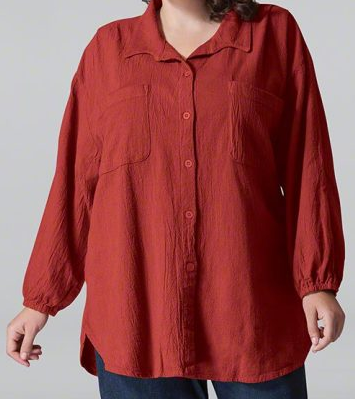 An entire site dedicated to plus sizes for women 1x-8x. “For over 30 years, On The Plus Side has been perfecting the fit and style of our plus size clothing for women. Over 90% of our clothing is made from natural fiber and designed to celebrate your curves.” You’ll need to check fabric content carefully, but I wanted to include this for the plus sizes, which can be difficult to find in natural fibers. While you have to sift through the blends, this Long Sleeve Oversize Shirt in the photo, for example, is 100% cotton and comes in 30 colors sizes 1x-8x. And it’s hand-dyed with eco-friendly dyes. So consider this site to be a treasure hunt.
An entire site dedicated to plus sizes for women 1x-8x. “For over 30 years, On The Plus Side has been perfecting the fit and style of our plus size clothing for women. Over 90% of our clothing is made from natural fiber and designed to celebrate your curves.” You’ll need to check fabric content carefully, but I wanted to include this for the plus sizes, which can be difficult to find in natural fibers. While you have to sift through the blends, this Long Sleeve Oversize Shirt in the photo, for example, is 100% cotton and comes in 30 colors sizes 1x-8x. And it’s hand-dyed with eco-friendly dyes. So consider this site to be a treasure hunt.
Hackwith Design House
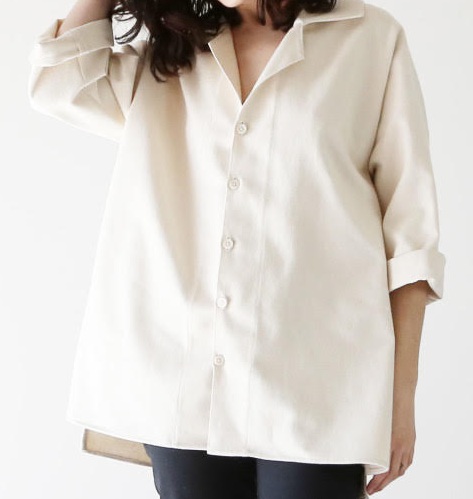 “Simple, beautiful clothing made in America.” All women’s sizes (choose HDH Plus from the Shop menu for plus sizes). Descriptions do not tell fabrics, but here’s why: “We source most of our fabrics from a local, family-owned fabric store that specializes in run-off and second-hand fabrics in order to cut down on waste while also supporting our local economy. As a result, we cannot always know the exact fiber content of the fabrics we buy. We strive to provide our customers with quality fabrics that are sourced in a responsible and environmentally-friendly manner. I can tell you however that any of our pieces listed on our website as being made of Cotton Slub, Cotton Gauze, Cotton Denim, or Hemp Silk and Organic Cotton are 100% natural fibers.” If you’re curious about any one particular piece, feel free to contact them and ask about fiber content.
“Simple, beautiful clothing made in America.” All women’s sizes (choose HDH Plus from the Shop menu for plus sizes). Descriptions do not tell fabrics, but here’s why: “We source most of our fabrics from a local, family-owned fabric store that specializes in run-off and second-hand fabrics in order to cut down on waste while also supporting our local economy. As a result, we cannot always know the exact fiber content of the fabrics we buy. We strive to provide our customers with quality fabrics that are sourced in a responsible and environmentally-friendly manner. I can tell you however that any of our pieces listed on our website as being made of Cotton Slub, Cotton Gauze, Cotton Denim, or Hemp Silk and Organic Cotton are 100% natural fibers.” If you’re curious about any one particular piece, feel free to contact them and ask about fiber content.
Tampon Tribe
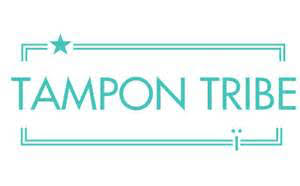 An affordable monthly subscription service for organic tampons, pads, and pantyliners. Toxin-free, plastic-free, chemical-free. Made from 100% certified organic cotton that is strictly monitored and regulated in all stages of production (GOTS: Global Organic Textile Standard, ICEA: European Eco/Bio Standard). Chlorine bleach and dioxin-free. There are no glues, synthetics, perfumes, bleaches or dyes used. Customize your box to get the right mix of pads, tampons, and pantyliners for your body.
An affordable monthly subscription service for organic tampons, pads, and pantyliners. Toxin-free, plastic-free, chemical-free. Made from 100% certified organic cotton that is strictly monitored and regulated in all stages of production (GOTS: Global Organic Textile Standard, ICEA: European Eco/Bio Standard). Chlorine bleach and dioxin-free. There are no glues, synthetics, perfumes, bleaches or dyes used. Customize your box to get the right mix of pads, tampons, and pantyliners for your body.
Bedworks of Maine
 Beds, bedroom, and convertible futon sofa frames made in Maine. “Classic lines, solid construction and gorgeous finishes are the hallmarks of the furniture we make at The BedWorks of Maine. All of our bedroom pieces and bed frames, both traditional and platform bed, as well as our futon frames are crafted out of North American ash, a sustainable and renewable hardwood.” Can be ordered unfinished.
Beds, bedroom, and convertible futon sofa frames made in Maine. “Classic lines, solid construction and gorgeous finishes are the hallmarks of the furniture we make at The BedWorks of Maine. All of our bedroom pieces and bed frames, both traditional and platform bed, as well as our futon frames are crafted out of North American ash, a sustainable and renewable hardwood.” Can be ordered unfinished.
Havelock Wool
 “Farm to walls” building insulation made from sheep’s wool. Made of 100% wool (with a small amount of natural boric acid added as an insect repellant). Their wool is sourced in New Zealand where sheep roam pastoral lands and eat grass in serene settings. It is blended and washed there before being shipped to their manufacturing facility in Nevada where they make both loose-fill and batt form insulation.
“Farm to walls” building insulation made from sheep’s wool. Made of 100% wool (with a small amount of natural boric acid added as an insect repellant). Their wool is sourced in New Zealand where sheep roam pastoral lands and eat grass in serene settings. It is blended and washed there before being shipped to their manufacturing facility in Nevada where they make both loose-fill and batt form insulation.
How Can I Keep My Food Cold?
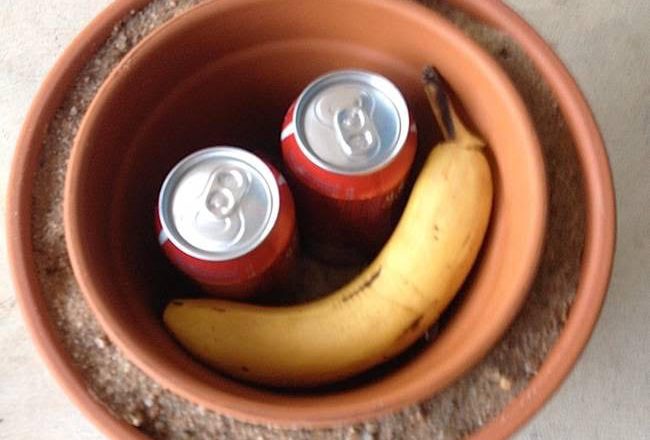
Instructions at Instructables
Question from Holly
Hi Debra,
Thanks so much for helping me become such a conscious consumer. Your work and advice is really appreciated!
I am on the hunt for a great cooler that will keep our stuff cold for a couple of days. After lots of research of the likes of Pelican, Yeti, and Bison, I came to realize that the stuff that keeps the ice frozen for so long is polyurethane foam insulation! This worried me, but THEN I found out that’s what is in our fridges.
Is this safe? The coolers are listed as having polypropylene shells (I am assuming that is the same plastic used for fridges) – does polypropelyne do a good job of containing VOCs within the walls of the cooler or fridge?
Also, Pelican soft coolers are made with double-coated 840D TPU; Yeti soft coolers are made of ColdCell™ foam insulation with EVA foam bottom – what are your thoughts on this regarding being so close to food etc.?
I’d love your input on this because I have done exhaustive research and can’t seem to find out anything!
Thanks.
Debra’s Answer
First of all, polyurethane foam isn’t a problem in coolers and refrigerators because it’s enclosed. As long as it’s sealed up inside something else, the fumes won’t get through.
The polypropylene shell is also fine. Polypropylene is one of the least toxic plastics. It’s used to make food storage containers. So I’m not really worried about that.
Now you asked if polypropylene would block VOCs. Great question. Here’s an interesting paper called Guidance on the Use of Plastic Membranes as VOC Vapor Barriers. But in a cooler you’re talking about a thick piece of plastic, not a membrane. That think piece would certainly block the VOCs.
Again, with refrigerators, the plastic would be thick enough to block VOCs. Here are the plastics used on the inside of your refrigerator:
Tough, impact- and corrosion-resistant plastics such as ABS, high impact polystyrene and polypropylene are used to create molded interior panels and door liners that help maximize usable space. Molded-in color means there is no paint or coating to peel over time. These panels are also moisture resistant, which helps them repel spills and stains. For clear drawers and compartment doors, polystyrene, polycarbonate and acrylic are the resins of choice, with durable polycarbonate often chosen for frequently used doors and compartments.
Thanks for asking this question. I didn’t know polycarbonate was used to make those crisper drawers. That’s the plastic with BPA.
TPU and EVA are both pretty nontoxic plastics. I’m not concerned about them.
As long and we’re on the subject, here are some links for insulating bags.
Here is a link to one similar to one I use and love. It has no outgassing. It’s a foil-lined cloth bag I purchased at my local natural food store.
www.ebay.com/itm/Insulated-Reusable-Grocery-Bag-Our-best-seller-2-pack-BLUE-CMW-/112471869875
You could use several inside each other for more insulation.
Also look at this cooler bag:
www.debralynndadd.com/debras-list/pack-cooler-bags
And here’s an article about how to keep your food cool without electricity:
www.treehugger.com/kitchen-design/fifty-buck-fridge-keeps-your-food-cool-without-electricity.html
Readers, what do you use to keep your food cold?
Affordable Organic Clothing for Plus Size Women

Oversized Linen Tunic Dress
Question from Marcella
Hi Debra,
I need your assistance to find affordable organic toxic free clothing but for Plus Size Women. If possible, I prefer a local store in my area where I can go to try them on. I live in Carson, CA in the Los Angeles County near San Pedro which is the Port of Los Angeles. If not, then online is the next best thing. In general, I wear size 1X in tops and 14W or 16W for pants/shorts.
I just want to be able to find clothing that is stylish yet within my budget so I do not break my bank account. I am not looking for clothes that makes one look like a hoochie mama or an old lady before my time. When it comes to clothes, I am very conservative yet fashionable.
I do not know if you have seen/read the link below on the internet. This lady hit it right on the nose when it came to shopping for organic plus size clothing for women. She understands my frustration completely.
www.greenandgorgeous.net/2012/08/07/wheres-all-the-plus-sized-eco-fashion
Debra’s Answer
As a plus size woman myself, I agree this blogger has hit it right on the nose. And I found another such post at
www.ecocult.com/sustainable-ethical-plus-sized-clothing
I am fortunate that my work-at-home lifestyle allows me to wear cotton tank tops and cotton capri pants most of the year here in Florida. I’ll admit that I have a drawer of neutral color pants and a drawer of colorful tank tops and my fashion choice go as far as pulling a pair of pants out of one drawer and a top out of the other and I’m dressed for the day.
But I do love fashion and used to be quite fashionable before I gave up all the synthetic fabrics to go natural.
I’ve been able to find cotton clothing in my size, and linen clothing too, just at department stores and even at places like TJMaxx and Ross Dress for Less. But it’s getting more and more difficult. I’m thinking about making my clothes or hiring someone to make them or even designing and selling my own line of clothing.
The blog mentioned by the reader lists some websites that have plus clothing. I went through the list and unfortunately I could only agree with three: Eileen Fisher ($$$ and sold only at fine department stores), Rawganique (already on Debra’s List) and Gaia Conceptions (which I’m adding to Debra’s List right now).
Check out the Clothing page on Debra’s List. You can search the page for “plus” and find the listings that have plus sizes. I’ve added a few new post for plus size natural fiber clothing that I found today.
And please let me know any plus size websites you find that you like so I can add them.
Just a comment…as I am looking though a number of websites on these “natural fiber plus size” lists, I’m seeing that what they think are natural fibers and I think are natural fibers are two different things. I think natural fibers are cotton, linen, silk, wool and other “whole” fibers. They think natural fibers are tercel, rayon, and other manufacurered items, or natural fibers mixed with spandex, polyester and other synthetics. So be sure to find the actual fabric content and check it out. Don’t assume “natural” is actually natural on clothing sites.






